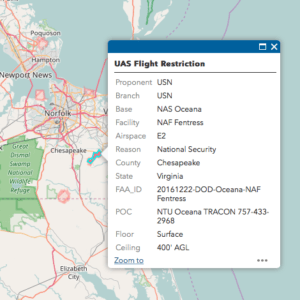
Vic Moss, an award winning photographer and licensed commercial drone pilot says that operators don’t need to be overly concerned about the announcement. Moss, who flies professionally in locations across the country, says that operators should take a moment to look at a map and see what the actual effect is. Moss is referring to the FAA’s interactive map, which can be found here. “It will save you a ton of agony and frustration,” suggests Moss on the UAV Legal News and Discussion Facebook page, which he moderates. “Go to the link, zoom in to your area, and toggle the UAS Flight Restrictions on and off. You’ll notice it affects very little flyable area.”
“There is nothing wrong with this,” says Moss.
While sensitive to some operators’ concerns that the new locations represent unchecked expansion of airspace restrictions, other droners comment that there should be no legitimate commercial operations over military bases anyway, unless contracted for by the military.
The specific restricted locations are detailed in a Notice to Airmen (NOTAM) – UAS NOTAM FDC 7/7137.
“U.S. military facilities are considered “sensitive” as they are vital to the nation’s security. The FAA and the Department of Defense have agreed to restrict drone flights up to 400 feet within the facility’s lateral boundaries,” says the FAA announcement. “There are only a few exceptions that permit drone flights within these restrictions, and they must be coordinated with the individual facility and/or the FAA. The restrictions are effective on April 14, 2017.”
“Operators who violate the airspace restrictions may be subject to enforcement action, including potential civil penalties and criminal charges.”
Miriam McNabb is the Editor-in-Chief of DRONELIFE and CEO of JobForDrones, a professional drone services marketplace, and a fascinated observer of the emerging drone industry and the regulatory environment for drones. Miriam has penned over 3,000 articles focused on the commercial drone space and is an international speaker and recognized figure in the industry. Miriam has a degree from the University of Chicago and over 20 years of experience in high tech sales and marketing for new technologies.
For drone industry consulting or writing, Email Miriam.
TWITTER:@spaldingbarker
Subscribe to DroneLife here.